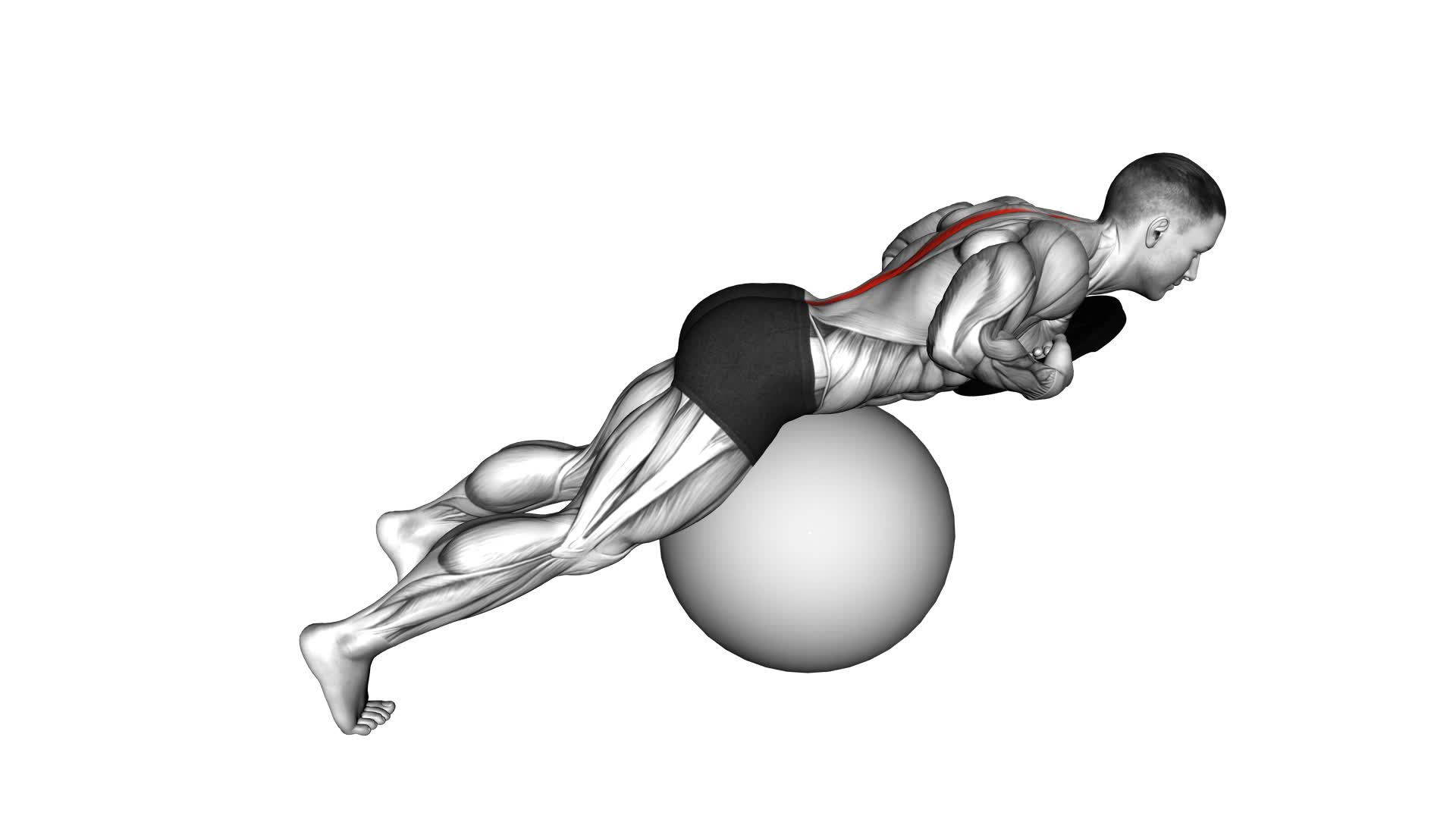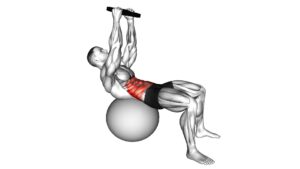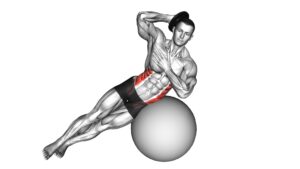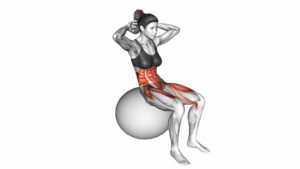Weighted Hyperextension (On Stability Ball) – Video Exercise Guide & Tips

Looking to strengthen your lower back and core? Get ready to try the weighted hyperextension on a stability ball.
Watch This Exercise Video
This exercise not only targets those key areas, but also improves stability and balance.
In this video exercise guide, you'll learn the proper form and technique, as well as variations to challenge yourself.
Maximize your results and avoid common mistakes by following these tips.
Let's get started and take your fitness to the next level.
Key Takeaways
- Weighted hyperextension targets the lower back and glutes, improving overall posture and reducing the risk of lower back pain.
- Adding weight increases the intensity of the exercise and improves stability and balance.
- When choosing weights, consider your fitness level and gradually increase resistance while maintaining good form.
- Variations of weighted hyperextension, such as using a barbell or resistance band, can challenge muscles in different ways and prevent plateaus.
Benefits of Weighted Hyperextension
Get stronger and improve your stability with weighted hyperextensions. Weighted hyperextensions are a great exercise that target your lower back and glutes, providing a range of benefits. One of the main benefits of weighted hyperextensions is that they help to strengthen your lower back muscles, which can improve your overall posture and reduce the risk of lower back pain. By adding weight to the exercise, you can also increase the intensity and challenge your muscles even more, leading to greater strength gains.
Additionally, weighted hyperextensions can also help to improve your stability and balance. As you perform the exercise, you engage and activate the muscles in your core, including your abs and obliques, which are crucial for maintaining stability during movements. This can be particularly beneficial for athletes and individuals who participate in sports that require a strong and stable core, such as gymnastics or martial arts.
There are several variations of weighted hyperextensions that you can incorporate into your workout routine, including using a stability ball, dumbbells, or a barbell. Each variation provides a slightly different challenge and targets different muscle groups, allowing you to customize your workout and target specific areas of your lower back and glutes.
Now that you understand the benefits of weighted hyperextensions, let's move on to the next section, where we'll discuss the equipment needed for performing this exercise.
Equipment Needed for Weighted Hyperextension
To perform weighted hyperextensions, you'll need a stability ball and weights. The stability ball provides the necessary support and range of motion for the exercise, while the weights add resistance for a more challenging workout.
When choosing weights, start with a lighter load and gradually increase as your strength and stability improve.
Necessary Equipment for Hyperextension
To perform a weighted hyperextension, you'll need an exercise stability ball. This equipment is essential for providing stability and support during the exercise.
Here are the necessary equipment for hyperextension:
- Exercise Stability Ball: This ball is specifically designed to provide stability and balance while performing hyperextension variations.
- Weight Plates or Dumbbells: These weights will add resistance to your hyperextension exercise, maximizing your results and allowing you to progressively increase the intensity.
- Weight Belt: A weight belt can be used to provide additional support to your lower back during the exercise, especially when using heavier weights.
- Exercise Mat: An exercise mat will provide cushioning and comfort during the hyperextension exercise, making it more enjoyable and protecting your body from unnecessary strain.
Now that you know the necessary equipment for hyperextension, let's move on to the next section about choosing the right weights.
Choosing the Right Weights
To choose the right weights for weighted hyperextension, consider your fitness level and gradually increase the resistance. It's important to find a weight that challenges you without compromising your form. Start with a weight that allows you to complete the exercise with proper technique and control.
As you become stronger and more comfortable with the movement, you can gradually increase the weight. This will help you continue to challenge your muscles and make progress. When selecting weights, it's also important to focus on maintaining good form throughout the exercise. Keep your core engaged, back straight, and avoid any jerky or excessive movements.
Proper Form and Technique for Weighted Hyperextension
Start by positioning yourself face-down on a stability ball, with a weighted plate held against your chest. Proper form and technique are essential to maximize the benefits of weighted hyperextension while avoiding injuries. Here's how to perform the exercise correctly:
- Engage your core muscles to maintain stability throughout the movement.
- Keep your feet hip-width apart and firmly planted on the ground for balance.
- Slowly lower your upper body towards the floor, maintaining a straight line from your head to your heels.
- As you descend, focus on squeezing your glutes and lower back muscles to lift your torso back up to the starting position.
Remember to breathe steadily throughout the exercise and avoid using momentum to lift your body. It's crucial to maintain control and perform the movement in a slow and controlled manner. Overextending your lower back or using excessive weight can increase the risk of injury, so start with lighter weights and gradually progress as your strength improves.
Variations of Weighted Hyperextension
Try incorporating different variations of weighted hyperextension to challenge your lower back muscles and keep your workouts interesting.
There are several advanced hyperextension techniques you can try to take your workout to the next level. One variation is the weighted hyperextension with a barbell. Instead of holding a dumbbell against your chest, you can place a barbell across your upper back and perform the exercise. This adds more resistance and engages your muscles in a different way.
Another variation is the single-leg weighted hyperextension. Instead of using both legs, you can perform the exercise while balancing on one leg. This challenges your core stability and targets one side of your lower back at a time.
Additionally, you can try the weighted hyperextension with a resistance band. Attach the band to a stable object and hold onto the other end while performing the exercise. This adds resistance throughout the movement and increases the challenge.
By incorporating these weighted hyperextension variations into your routine, you can continue to challenge your lower back muscles and prevent plateaus.
Now, let's move on to the next section to learn some tips for maximizing your results with weighted hyperextension.
Tips for Maximizing Results With Weighted Hyperextension
To maximize your results with weighted hyperextension, it's important to focus on proper form techniques and appropriate weight selection.
Maintaining a neutral spine, engaging your core, and squeezing your glutes at the top of the movement will ensure that you're targeting the right muscles and avoiding injury.
Additionally, starting with a weight that challenges you but still allows you to maintain proper form will lead to better results over time.
Proper Form Techniques
Achieve optimal results with weighted hyperextension by maintaining proper form throughout the exercise. Here are some techniques to help you maximize your results:
- Focus on weight distribution: Make sure to evenly distribute the weight on the stability ball to maintain balance and stability during the exercise.
- Engage your core: Keep your core muscles engaged throughout the movement to protect your lower back and maintain stability. This will also help you target your abdominal muscles.
- Maintain a neutral spine: Keep your spine in a neutral position throughout the exercise. Avoid arching or rounding your back excessively.
- Control the movement: Slowly lower your upper body towards the ground and then raise it back up using controlled movements. Avoid any jerky or sudden movements that can strain your back.
Appropriate Weight Selection
To maximize your results with weighted hyperextension, it's important to select an appropriate weight while focusing on maintaining proper form. The weight you choose should challenge your muscles without compromising your technique. Start with a weight that allows you to perform the exercise with control and stability.
As you progress, gradually increase the weight to continue challenging your muscles and promoting muscle activation. It's important to listen to your body and avoid using weights that are too heavy, as this can lead to poor form and potential injury. By gradually increasing the weight over time, you can effectively strengthen your lower back and glutes while minimizing the risk of injury.
Now that you understand the importance of appropriate weight selection, let's move on to discussing common mistakes to avoid during weighted hyperextension.
Common Mistakes to Avoid During Weighted Hyperextension
One common mistake to avoid during weighted hyperextension is using too much weight. While it may be tempting to push yourself with heavier weights, using too much weight can actually hinder your progress and increase the risk of injury.
To maximize your results and perform this exercise safely, here are some common mistakes to avoid:
- Using excessive weight: Using weights that are too heavy can compromise your form and put unnecessary strain on your lower back. Start with a lighter weight and gradually increase as your strength improves.
- Arching your back excessively: Hyperextending your back beyond its natural range of motion can lead to lower back pain and injury. Keep your back straight and maintain a neutral spine throughout the exercise.
- Not engaging your core: Neglecting to engage your core muscles can weaken the stability of your spine and limit the effectiveness of the exercise. Be sure to activate your core by pulling your belly button towards your spine.
- Relying on momentum: Swinging your body during the exercise not only reduces the effectiveness of the movement but also increases the risk of injury. Focus on controlled and deliberate movements to target the desired muscles effectively.
Frequently Asked Questions
Can Weighted Hyperextensions Be Done Without a Stability Ball?
Yes, you can do weighted hyperextensions without a stability ball. Weighted hyperextensions are a great exercise for strengthening your lower back and glutes. By adding weight, you increase the intensity and challenge your muscles even more.
There are different variations of hyperextensions that can be done with or without equipment. However, using a stability ball provides an unstable surface, which engages your core muscles for added stability and balance during the exercise.
How Often Should Weighted Hyperextensions Be Performed for Optimal Results?
To get optimal results, you should perform weighted hyperextensions regularly. By gradually increasing the difficulty, you can progress the exercise.
Incorporating weighted hyperextensions into your full body workout routine has numerous benefits. It strengthens your lower back, glutes, and hamstrings, improving overall stability and posture. Additionally, it helps prevent back injuries and enhances athletic performance.
Remember to consult a professional trainer to ensure proper form and technique for maximum effectiveness.
Can Weighted Hyperextensions Help With Lower Back Pain?
Weighted hyperextensions can be beneficial for lower back pain. By incorporating weighted hyperextensions into your strength training routine, you can strengthen the muscles in your lower back, which can help alleviate pain and improve stability.
These exercises target the erector spinae muscles, which play a crucial role in supporting your spine. However, it's important to start with lighter weights and gradually increase as you build strength.
Always consult with a healthcare professional before starting any new exercise program.
What Are Some Alternative Exercises That Target the Same Muscles as Weighted Hyperextensions?
If you're looking for alternative exercises that target the same muscles as weighted hyperextensions, there are a few options.
One option is the back extension exercise, which can be done on a hyperextension bench or stability ball.
Another option is the good morning exercise, which targets the lower back, glutes, and hamstrings.
Both of these exercises can help strengthen your lower back and improve stability.
However, be sure to consult with a professional before starting any new exercise routine.
Is It Necessary to Use Weights When Performing Hyperextensions on a Stability Ball?
Using weights during hyperextensions on a stability ball can offer several benefits. It increases the intensity of the exercise, helping to build strength and muscle in your lower back and glutes.
However, it isn't necessary to use weights if you're a beginner or if you prefer to focus on form and technique first. Remember to maintain proper form by keeping your core engaged, your back straight, and using controlled movements throughout the exercise.
Conclusion
In conclusion, weighted hyperextension is a highly effective exercise that targets the lower back muscles and improves overall stability. By using a stability ball and adding weights, you can increase the intensity of the exercise and maximize your results.
Proper form and technique are crucial to avoid injury, and there are variations of the exercise that can be incorporated for added challenge. Remember to follow these tips and avoid common mistakes to get the most out of your weighted hyperextension workouts.

Author
Years ago, the spark of my life’s passion ignited in my mind the moment I stepped into the local gym for the first time. The inaugural bead of perspiration, the initial endeavor, the very first surge of endorphins, and a sense of pride that washed over me post-workout marked the beginning of my deep-seated interest in strength sports, fitness, and sports nutrition. This very curiosity blossomed rapidly into a profound fascination, propelling me to earn a Master’s degree in Physical Education from the Academy of Physical Education in Krakow, followed by a Sports Manager diploma from the Jagiellonian University. My journey of growth led me to gain more specialized qualifications, such as being a certified personal trainer with a focus on sports dietetics, a lifeguard, and an instructor for wellness and corrective gymnastics. Theoretical knowledge paired seamlessly with practical experience, reinforcing my belief that the transformation of individuals under my guidance was also a reflection of my personal growth. This belief holds true even today. Each day, I strive to push the boundaries and explore new realms. These realms gently elevate me to greater heights. The unique combination of passion for my field and the continuous quest for growth fuels my drive to break new ground.







